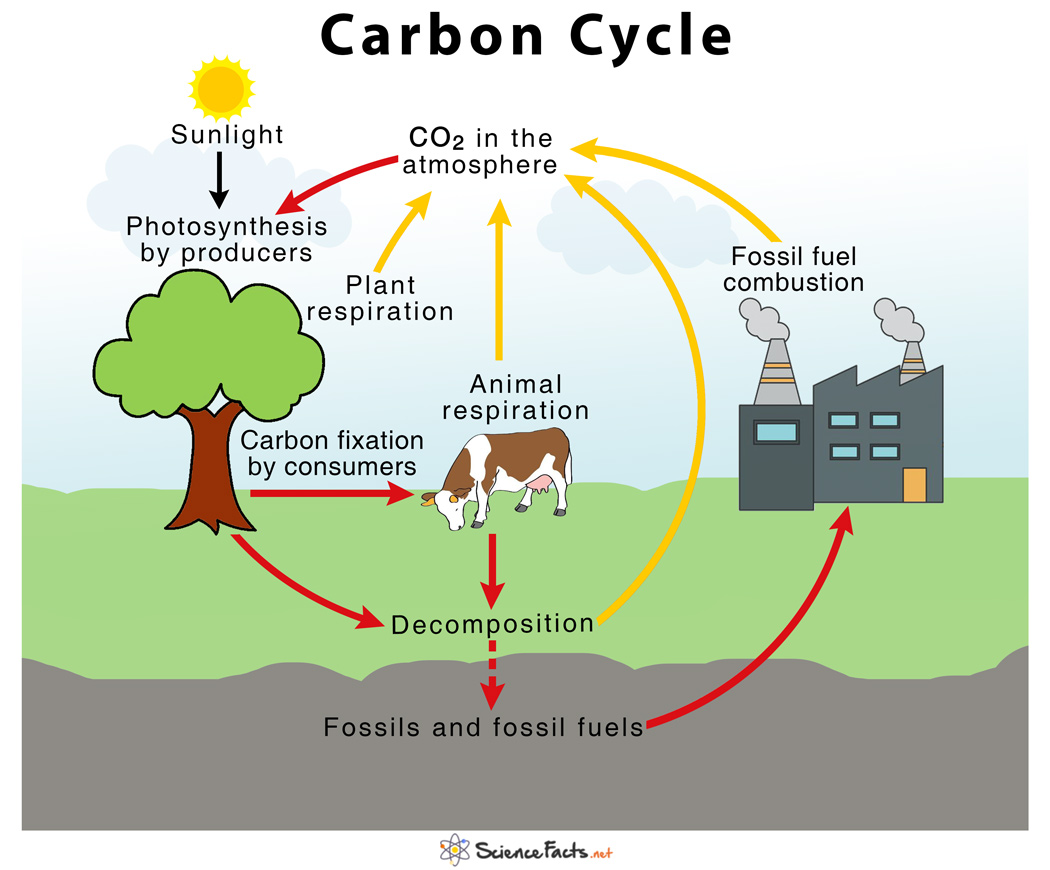Ecology Reading 3: Carbon Cycle
What is Carbon and Why is it Important?
Carbon is a special element that is found in many things around us, like in air (carbon dioxide), living things (biomass), and even in dead plants and animals (decomposing matter). Carbon is always moving between different parts of Earth in a cycle, which means it is constantly changing and moving from one place to another.
The Big Four Processes of the Carbon Cycle:
Photosynthesis (How plants "catch" carbon)
Plants take in carbon dioxide from the air and water from the ground.
Using sunlight, plants make food (glucose) and release oxygen into the air.
This is a way to “trap” carbon from the air into the plant as biomass (plant material).
Cellular Respiration (How living things "release" carbon)
Animals (and plants at night) breathe in oxygen and eat food (glucose).
When they burn glucose for energy, they release carbon dioxide back into the air and water as waste.
Decomposition (How dead things release carbon)
When plants and animals die, they break down and decay.
This process releases carbon back into the air or soil as carbon dioxide or methane.
Combustion (Burning fossil fuels)
Burning things like oil, coal, and natural gas (fossil fuels) adds carbon dioxide to the air.
This is called combustion.
Where Does Carbon Go?
Biosphere: All living things (plants, animals, bacteria).
Atmosphere: The air we breathe, filled with carbon dioxide.
Hydrosphere: The oceans, lakes, and rivers, which also take in and release carbon.
Geosphere: The Earth’s land, including soils and fossil fuels like coal and oil.
Why is This Important?
More carbon dioxide in the air can make the Earth warmer (this is part of global warming).
Too much carbon dioxide in the water can make it more acidic, which can hurt ocean animals like fish and corals.

Key Words to Remember:
Carbon dioxide (CO₂): A gas that plants take in and animals release.
Biomass: The mass of living things, like plants and animals.
Fossil fuels: Dead plants and animals that became oil, coal, or natural gas over millions of years.
Oxygen: A gas that is released by plants during photosynthesis and needed by animals for breathing.
This topic helps us understand how the Earth works as a big system that is always changing, with carbon moving between the air, water, and land. It’s important to know how all of these processes are connected to each other!
VOCABULARY
Vocabulary List: Carbon and Its Cycle
Carbon
Definition: A chemical element found in all living things, as well as in gases, water, and fossil fuels.
Example: Carbon is part of every living organism and is found in the atmosphere as carbon dioxide.
Photosynthesis
Definition: The process by which plants use sunlight to make food from water and carbon dioxide, turning carbon dioxide into plant matter (biomass).
Example: Kelp in the ocean takes in carbon dioxide and turns it into glucose and oxygen.
Cellular Respiration
Definition: The process in cells where glucose and oxygen are used to produce energy (ATP), with carbon dioxide and water as waste products.
Example: After eating, your cells break down food to create energy, releasing carbon dioxide as a byproduct.
Decomposition
Definition: The breakdown of dead plants and animals into simpler parts, returning carbon and other materials to the soil and atmosphere.
Example: Fallen leaves decompose in the fall, enriching the soil with nutrients for new plants.
Combustion
Definition: The burning of materials (like fossil fuels or wood) that releases carbon dioxide into the atmosphere.
Example: Burning wood in a fireplace produces carbon dioxide as part of the combustion process.
Carbon Dioxide (CO₂)
Definition: A gas that is a key component of Earth's atmosphere, contributing to the greenhouse effect and global warming. It also increases water acidity.
Example: When you breathe out, you release carbon dioxide, which plants use for photosynthesis.
Biomass
Definition: The total amount of living matter in an area, including plants and animals, which can store carbon.
Example: Trees and plants in a forest are examples of biomass, storing carbon from the atmosphere.
Hydrocarbons
Definition: Compounds made only of carbon and hydrogen, commonly found in fossil fuels.
Example: Gasoline and natural gas are made of hydrocarbons, which release carbon dioxide when burned.
Biosphere
Definition: All the living organisms and ecosystems on Earth.
Example: The biosphere includes forests, oceans, deserts, and all areas where life exists.
Atmosphere
Definition: The layer of gases surrounding Earth, primarily nitrogen, oxygen, and small amounts of carbon dioxide and other gases.
Example: The atmosphere helps maintain Earth's temperature by trapping heat from the sun.
Hydrosphere
Definition: All of Earth's water, including oceans, lakes, rivers, and glaciers.
Example: The ocean is part of the hydrosphere and absorbs a lot of carbon dioxide from the air.
Geosphere
Definition: The solid part of Earth, including rocks, landforms, and the materials beneath the surface where carbon is stored.
Example: Fossil fuels like coal are stored in the geosphere and release carbon dioxide when burned.
Carbon Cycle
Definition: The movement of carbon through the Earth's atmosphere, biosphere, hydrosphere, and geosphere, involving processes like photosynthesis, respiration, combustion, and decomposition.
Example: Carbon moves from the air to plants and soil, and back into the atmosphere when plants decompose.
Carbon Neutral
Definition: A balance between the amount of carbon dioxide emitted and the amount removed, resulting in no net increase in carbon levels.
Example: A company that plants trees to offset its carbon emissions is working towards being carbon neutral.
Carbon Sink
Definition: A natural environment that absorbs more carbon dioxide than it releases, helping to reduce atmospheric carbon.
Example: Forests and wetlands are carbon sinks that store large amounts of carbon in trees and soil.
Carbon Emission
Definition: The release of carbon dioxide into the atmosphere, often from human activities like burning fossil fuels.
Example: Cars emit carbon dioxide when they burn gasoline, contributing to air pollution.